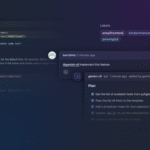The future where robots seamlessly integrate into our work and home environments isn’t a distant dream anymore—it’s already happening. Powered by large language models (LLMs), robotics is on the cusp of transforming both professional workplaces and personal living spaces in ways we could have only imagined a decade ago. By merging advanced robotics with LLMs, machines can now understand and respond to human language with unprecedented accuracy, making them more versatile, autonomous, and intelligent. This fusion is set to revolutionize the way we work, manage our homes, and even live our day-to-day lives.
Professional Impact: Workplaces Are Evolving
- Advanced Automation Has Already Begun Industries across the globe are already integrating LLM-powered robots into their workflows. In manufacturing, these robots don’t just follow pre-programmed routines anymore—they can interpret complex instructions, troubleshoot issues in real time, and communicate with human supervisors in natural language. This level of automation is allowing companies to scale up production without sacrificing quality, reducing the need for extensive human intervention. Take automotive factories, for example, where robots are now capable of assembling parts, analyzing assembly line data, and even predicting when a machine will break down.Similarly, in healthcare, robots are beginning to assist with everything from administrative tasks to surgery preparation. They can sift through vast medical databases, interpret patient records, and suggest treatment options, giving doctors more time to focus on patient care. This is no longer science fiction—AI-powered robots have already started enhancing patient outcomes in hospitals worldwide.
- Human-Robot Collaboration Is Already Improving One of the most immediate changes we’re seeing is how robots, thanks to LLMs, can now understand and act on human instructions without complex programming. Workers in fields like logistics, construction, and engineering are already collaborating with these machines, delegating specific tasks and receiving real-time updates in natural language. For instance, on construction sites, robots can take on heavy lifting while providing progress reports and flagging issues through voice commands. This collaboration boosts efficiency and makes advanced robotics accessible to non-technical workers.The retail sector is also starting to see the impact. In some stores, LLM-equipped robots help manage inventory, restock shelves, and even assist customers with product information, answering queries in a conversational manner that feels human-like. This marks the beginning of a larger trend where robotics will handle repetitive or labor-intensive tasks, freeing human employees to focus on higher-level responsibilities.
- Data Analysis and Predictive Capabilities In data-driven industries like finance, marketing, and law, LLM-powered robots are transforming how professionals analyze data and make decisions. Imagine a legal team using a robot to sift through hundreds of case files, pulling out relevant information in seconds. In the financial sector, AI-driven bots are already helping analysts make sense of market trends, identifying patterns and offering predictions based on vast datasets. This type of AI-augmented decision-making is just the tip of the iceberg, and we’ll soon see it integrated into nearly every industry.Predictive maintenance in factories, personalized marketing campaigns, and even AI-driven investment strategies are already being powered by LLM-backed robotics, setting the stage for a future where data analysis and decision support are faster, more accurate, and more insightful than ever before.
Household Impact: Smarter Homes Are Already Emerging
- LLM-Driven Home Assistants The presence of AI-powered home assistants like Alexa and Google Home has become common, but these are just the early stages. With the integration of LLMs, household robots are becoming much more intelligent and personalized. We’re already seeing robots that can handle more complex household tasks—cleaning, cooking, and even caregiving. The difference now is that these robots can learn from your preferences, adapt to your daily routines, and even understand conversational context, making them indispensable members of modern homes.For instance, imagine a robot that knows your preferred morning routine: it starts your coffee, adjusts the lighting, reminds you of your meetings for the day, and suggests what to wear based on the weather. It’s not just voice-controlled automation anymore; these robots, powered by LLMs, are intelligent enough to anticipate your needs, manage your schedule, and provide personalized recommendations—functionality that has already started appearing in high-end smart homes.
- Household Chores and Management Home robotics are already improving how we manage day-to-day tasks. Robots equipped with LLMs can vacuum the floor, reorder household supplies, or even identify when an appliance needs repair and book a technician, all based on natural language commands or predictive behaviors. This integration is taking the burden of home maintenance off our shoulders, allowing more time for leisure or personal development. We’ve begun to see this with smart vacuums that map homes, understand voice commands, and autonomously keep the house clean—these are just the early stages of much more advanced home management systems.As LLM technology becomes more sophisticated, these robots will manage entire households, coordinating with other smart devices, optimizing energy use, and taking care of mundane chores like dishwashing or laundry without human intervention.
- Elderly and Healthcare Support at Home The demographic shift towards aging populations worldwide is already being addressed by LLM-powered robotics in home care. Robots that provide elderly care are starting to monitor vital signs, remind individuals to take their medication, and assist with mobility around the house. This isn’t just a vision for the future—it’s happening today, with several pilot programs in countries like Japan and Germany already deploying robots in homes to assist the elderly.These robots can engage in conversations, offering companionship to individuals who might otherwise feel isolated, and can alert emergency services if a health issue arises. In the near future, these robots will likely be integrated with wearable health devices, offering real-time health monitoring and predictive health interventions.
Takeaway: The Future is Now
Robotics integrated with large language models is not just a theoretical breakthrough—it’s a reality that’s already beginning to reshape industries and homes alike. The ability for robots to understand and act on natural language, thanks to LLMs, is unlocking new levels of automation, collaboration, and personalization in both professional and domestic settings. In workplaces, LLM-powered robots are enhancing productivity, improving decision-making, and enabling seamless collaboration between humans and machines. At home, these intelligent robots are providing personalized assistance, managing household tasks, and even supporting healthcare and elderly care.
The future where robots assist us in every aspect of life isn’t something we’re waiting for—it’s something we’re already living.









